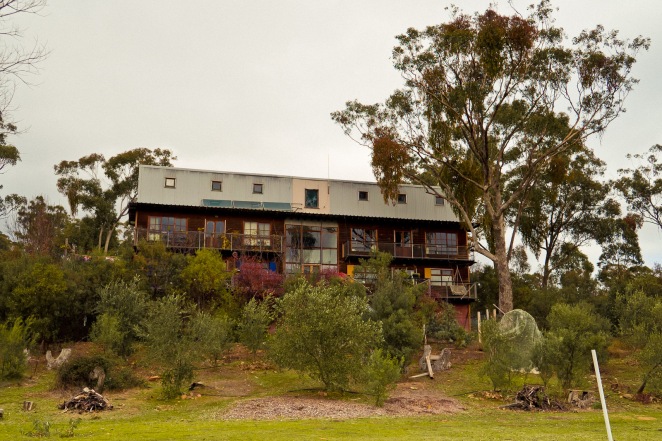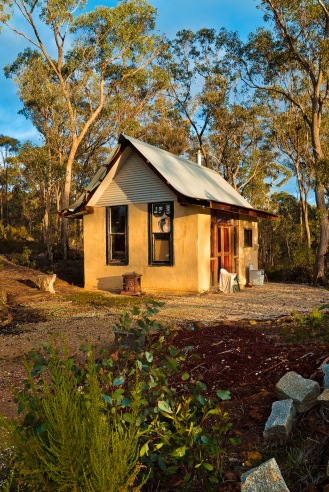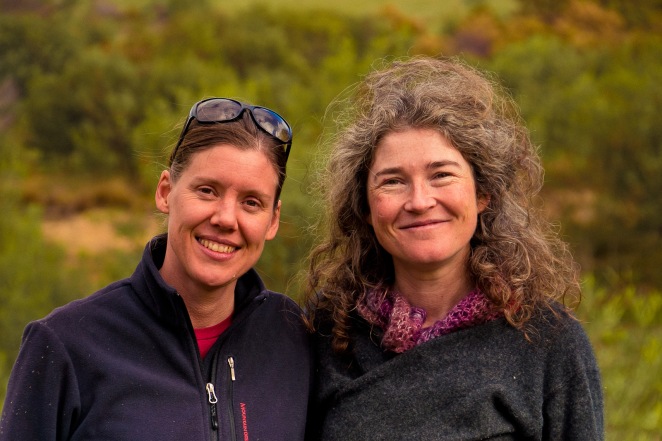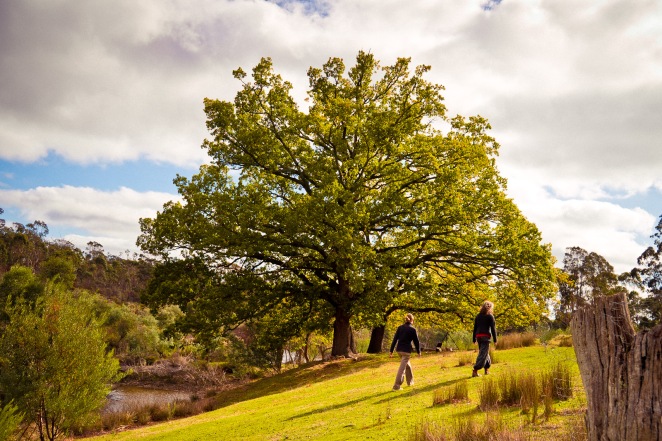~ DESTINATION EIGHT: FRYERSTOWN ~
Built on pioneer David Holmgren’s principles, Fryers Forest is an eco-haven in Central Victoria
At the outset of this trip, I thought that we might be seeing a community “blueprint” that was repeated in each place we visited, with perhaps different variations on the theme. However, as I mentioned in my previous blog entry, not only does the term “community” carry so many different possible meanings, but the look and feel of each one is so varied that the only thing they all have in common is an intent to live together in some sort of deliberate way. Beyond this, the personalities and temperaments, village characteristics, geographical features, group focus, lifestyle choices, governance, spirituality and long-term vision have come in every flavour, shape, size and colour.
If our trip was actually about seeking a place for us to call home (which it may or may not be – we don’t know yet!), it might be a bit like deciding on what take-away food to get for the evening: for example, if I were trying to choose between Indian, Pizza, Thai, Middle Eastern and fish n’ chips (all delicious types of foods I love), other than rudimentary differences (starches, certain vegetables, etc.) all are very unique and difficult to compare directly. It’s not a bad situation to be in – picking from a great collection of options – but it begs the question of whether you just need to settle with a community that offers many things you want and others you don’t, or, cherry-picking ideas and putting the hard-yards in to build our own community. The trouble with the latter is threefold (at least):
- most of these communities were started by people in their 20’s, bubbling with passion, energy and physically in their prime (we’re in that 40’s zone)
- we need a significant financial base to start with (we have no Savings)
- there is a staggering amount of research and paperwork – legal and political – to set it up and manage it, even if you want a basic and organic type of community (I’m not unwilling to do research, etc. but the legal/financial/policy stuff is a deterrent)
 Beyond this, of course, is finding people who wish to share in your vision and are keen to see it through. The more communities I see, the more I have personally honed a vision compiling the best elements of all of them into my own community ideas, but have been equally tempered by my increasingly reluctance to have to go through the many years required to get the community off the ground having heard what is involved from those who have done it.
Beyond this, of course, is finding people who wish to share in your vision and are keen to see it through. The more communities I see, the more I have personally honed a vision compiling the best elements of all of them into my own community ideas, but have been equally tempered by my increasingly reluctance to have to go through the many years required to get the community off the ground having heard what is involved from those who have done it.
Enter Fryer’s Forest, a pleasant village consisting of 11 freehold plots on a shared 300-acre gumtree-covered property, 20 minutes drive south-east of Castlemaine, Victoria. Having completed another WWOOFing stretch of physical labour here this week, it reminds me just how much work is involved in keeping up and evolving a community. Of course, that’s just the physical maintenance; there’s also the people management which can be much trickier. Our hosts here at Fryers, Tamsin and Toby, have possibly found one of the loopholes to my DIY community conundrum though: they moved to this community shortly after its inception and have been able to ride the benefits of being an original (if not “founding”) member, helping shape the evolution of the village and feel that they have been involved since the beginning yet without having to go through the several years of starting the process, acquiring the land, council negotiations, etc. While I am personally attracted to having a say in the layout and design of the community, perhaps this can still happen on some level if I were to get in early enough but not too early.
My own creation desires aside, Fryers Forest is an interesting place and I’m starting to see the virtues of their way of doing community, even if I wasn’t feeling the love as much initially. The closest town is Fryerstown, a hamlet consisting of about 400 people (which likely includes the 35+ folks of Fryers Forest), but the land was formerly a part of the Victorian gold rush 160-odd years ago when around 15,000 people would have lived in the area.  Surrounded by thick forest and a peace and quiet we don’t often experience in our urban world, it is difficult to imagine it with gold diggers at every turn. The town was built back in the early 1990’s on permaculture roots with pioneer David Holmgren contributing heavily to Fryers’ original design. As our host Tamsin showed us on a tour of the property, there are permaculture considerations at every turn: tree thinning, top soil catchments (swales), building placements for sun orientation, water capture and transfer, low waste yields, the encouraging of fauna diversity on the property and many more things. For those not familiar with permaculture’s principles, they are essentially: take care of the Earth; take care of the people; and set limits for population and consumption. From what we could see, Fryers’ members took these principles seriously.
Surrounded by thick forest and a peace and quiet we don’t often experience in our urban world, it is difficult to imagine it with gold diggers at every turn. The town was built back in the early 1990’s on permaculture roots with pioneer David Holmgren contributing heavily to Fryers’ original design. As our host Tamsin showed us on a tour of the property, there are permaculture considerations at every turn: tree thinning, top soil catchments (swales), building placements for sun orientation, water capture and transfer, low waste yields, the encouraging of fauna diversity on the property and many more things. For those not familiar with permaculture’s principles, they are essentially: take care of the Earth; take care of the people; and set limits for population and consumption. From what we could see, Fryers’ members took these principles seriously.
Our time was largely spent labouring for our hosts with wood chopping, tidying up the remains of three huge felled 100-year old trees, cleaning gutters and helping around the property. We came at a time where they were exhaustedly managing energetic 4 year-old twins while still helping neighbours with their needs: helping shift wood from the felled trees to use as a neighbour’s new home-building material, a working bee digging rain gutters on the roads, “taking care” of a nasty rooster for a friend, looking after friends’ kids while they were busy, and so on. It became increasingly apparent that the “community” part of their intentional living arrangement was quite active and involved. Tamsin and Toby both admitted that if they were unable to continue living at Fryers, they wouldn’t know what to do as they loved living there so much.
On the surface, Fryers wasn’t all that different from Moora Moora in that people could buy and sell their own land (though MM was as a cooperative arrangement and FF was completely freehold strata style), they lived in a loose village layout with a limited-use central “hub”, they both began using permaculture principles and were both off-grid on an isolated property about 20 minutes drive from a regional town. Interestingly, whereas other places we have visited have either their spirituality and/or social conscience to unify the community members, both of these communities only share their environmental interests (and separation from mainstream society) as the glue that keeps them together. A key difference separating Fryers from Moora Moora though was that the overall community was smaller and the houses were clustered much closer together. I reckon this contributes a great deal to the active interaction between groups. It is of course unfair to directly compare any of the communities as the personalities, planning specifics and overall history have simply made things the way they are, but physical proximity still feels like something that I imagine helps connect people better.
The first four days at Fryers Forest were all about the work around their hand-designed and built home, and even our hosts kept apologising for not taking us into the community-at-large proving that other people do actually live here. Opportunities arose when Toby’s weekly men’s night arrived and I spent a couple of hours with the boys at their community space (an old fibro school house that was transported from nearby Fryerstown) to have some drinks, chats, smokes (not I of course 😀 ) and backgammon. Granted, not everyone was from Fryers itself, but I was able to see the centralised facilities at work plus the bonding between the lads. Heidi had a similar “Happy Hour” experience the following night with the girls playing scrabble in Fryerstown, and we further got to know various people in the village through work we did and via roadside conversations. Further to the idea of member interaction, Tamsin recounted many other aspects of community life she had experienced over the years – particularly with difficult parenting times – like when she would call out on their walkie-talkie system (each house is on the same channel and all have a walkie) that she desperately needed someone to take the kids off her hands, and someone would always immediately arrive to help. Or how the group bus brings the village kids to schools,  how people help one another with their home building projects, how on one year together they built a pedal-powered machine to crush tomatoes to make organic pasta sauce for the village, or how the group holds barbecue events where dancing and carrying-on ensues on the foreshore of their man-made lake/dam on warm summer evenings. The more they thought of it, the more great memories began to flow.
how people help one another with their home building projects, how on one year together they built a pedal-powered machine to crush tomatoes to make organic pasta sauce for the village, or how the group holds barbecue events where dancing and carrying-on ensues on the foreshore of their man-made lake/dam on warm summer evenings. The more they thought of it, the more great memories began to flow.
Despite being more of a middle-class suburb of folks wanting to live outside the anonymity of the city with no external bond seemingly joining them, Fryers Forest seems to be doing pretty well. They just had all of their eleven property sites purchased now and on the way to be occupied for the first time in years, so there is reason to feel optimistic about their future. When I first arrived, I wasn’t feeling the community vibe: the forest was dry and the land was hard; but pushing past the superficial aesthetics and getting to know Tamsin and Toby’s family and their neighbours, I started to warm to what they had achieved here. It certainly has a lot of intriguing elements to look if we were thinking of setting up a new community, and I suspect with a longer evaluation, Fryers Forest itself could be a place that could be spent enjoying for many years.
As usual, Heidi’s own perspective and thorough write-up about our visit can be read on her blog!











I stumbled on your blog today. Gryph and Tyco will be 11 on Tuesday! Great reading and lively photos! Cath from Lot 11, Fryers Forest.
LikeLike
Nice to hear from you Cath. Glad you enjoyed the blog! Can’t believe it has already been 6 years since we visited. Has much changed in that time? Say hi to Tamsin and Toby if you see them 🙂
LikeLike